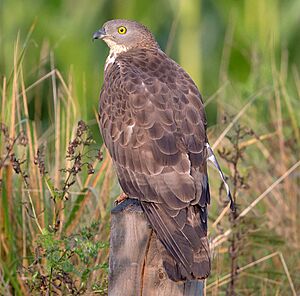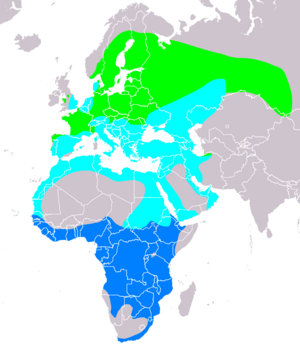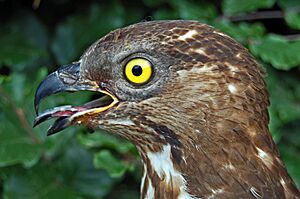European honey buzzard facts for kids
Quick facts for kids European honey buzzard |
|
|---|---|
 |
|
| Adult bird in Germany | |
| Conservation status | |
| Scientific classification | |
| Genus: |
Pernis
|
| Species: |
apivorus
|
 |
|
| Range of P. apivorus Breeding Non-breeding Passage | |
| Synonyms | |
|
Falco apivorus Linnaeus, 1758 |
|
The European honey buzzard (Pernis apivorus), also known as the pern, is a fascinating bird of prey. This amazing bird belongs to the Accipitridae family, which includes eagles, hawks, and kites. It's known for its special diet and long journeys.
Contents
Understanding the Honey Buzzard's Name
The European honey buzzard was first officially described in 1758. A Swedish scientist named Carl Linnaeus gave it the scientific name Falco apivorus. He put it in the same group as falcons and eagles.
Later, in 1816, another scientist named Georges Cuvier created a new group, or genus, called Pernis just for birds like the honey buzzard. The word Pernis comes from an old Greek word for a bird of prey.
The second part of its name, apivorus, comes from Latin. Apis means "bee" and -vorus means "eating". So, apivorus means "bee-eating". However, this bird actually eats more wasps than bees! Because of this, in some languages like German, it's called "wasp buzzard".
Even though its English name includes "buzzard", this bird is not closely related to the true buzzards you might know. It's actually more like kites.
What Does the Honey Buzzard Look Like?
The European honey buzzard is a medium-sized bird, about 52 to 60 centimeters (20 to 24 inches) long. Its wingspan can reach an impressive 135 to 150 centimeters (53 to 59 inches). This makes it larger and longer-winged than the common buzzard.
When it flies, it looks like it has a long neck and a small head. It often soars with its wings held flat. Its tail is longer than a common buzzard's and usually has two thin dark stripes and one wide dark stripe near the end.
You can often tell male and female honey buzzards apart by their feathers. This is quite rare for large birds of prey! Males have a blue-grey head, while females have a brown head. Females are also a bit bigger and darker than males.
When soaring, honey buzzards hold their wings straight. Their wingtips might be flat or point slightly downwards. Their head sticks out forward with a slight bend. They sometimes have a very angled chest, similar to a sparrowhawk. Their call sounds like a clear peee-lu.
Special Features for Hunting Wasps
Honey buzzards have some cool adaptations for their diet. They have special scale-like feathers around their eyes and forehead. These feathers act like armor, protecting them from wasp stings when they dig into nests.
Their claws are also quite straight, which helps them dig into the ground to find wasp nests. They also have long toes that are good for raking through soil. Scientists think their feathers might even have a special chemical that keeps wasps away!
Where Do Honey Buzzards Live and Travel?
The European honey buzzard is a migratory bird. This means it travels long distances between its breeding grounds and its winter homes. It spends its summers in a part of Europe and Asia called the western Palearctic. This area stretches from most of Europe all the way to southwestern Siberia.
These birds can be found in many different places, but they usually prefer woodlands and tree plantations. When winter comes to Europe, they fly south to tropical Africa.
Amazing Migratory Journeys
Honey buzzards are long-distance travelers. They use the Earth's magnetic field to help them find their way south. They also remember important landmarks like mountain ranges and rivers.
These birds avoid flying over large areas of water because they can't soar there. So, you can see huge numbers of honey buzzards crossing the Mediterranean Sea at its narrowest points. Places like the Gibraltar Strait, the Messina Strait, and Israel are famous spots for watching their migration.
How Honey Buzzards Act
Honey buzzards are often seen soaring high in the sky on warm air currents called thermals. When they fly through forests, they usually stay quite low. They often perch in the middle of trees, holding their body flat with their tail hanging down.
They also hop from branch to branch, flapping their wings once with each hop. This makes a loud clapping sound. These birds often seem restless, ruffling their wings and moving around on their perch. They will often tilt their head to get a good look at places where food might be hiding. This behavior can remind you of a curious parrot.
Reproduction and Family Life
Honey buzzards build their nests in woodlands. They are usually hard to spot, except in the spring when they perform their mating displays. During these displays, the male will clap his wings together.
Male honey buzzards are very protective of their nesting areas. A female honey buzzard usually lays two eggs, but sometimes one or three. The eggs are about 5.1 by 4.1 centimeters (2 by 1.6 inches) and are covered in brown marks on a white or light cream background. It's rare for one chick to kill another in the nest.
What Do Honey Buzzards Eat?
The European honey buzzard is a very specialized eater. Its main diet consists of the larvae (young) and nests of wasps and hornets. They will also sometimes eat small mammals, reptiles, and other birds.
Interestingly, it's the only known predator of the Asian hornet. Honey buzzards spend a lot of time on the forest floor, digging up wasp nests. Their special claws and feathers help them with this unique way of finding food.
Honey Buzzards in History
In the past, honey buzzards were sometimes eaten by people in Europe. Texts from the 1800s mention that they were often caught in winter. They were described as "fat and delicious eating."





